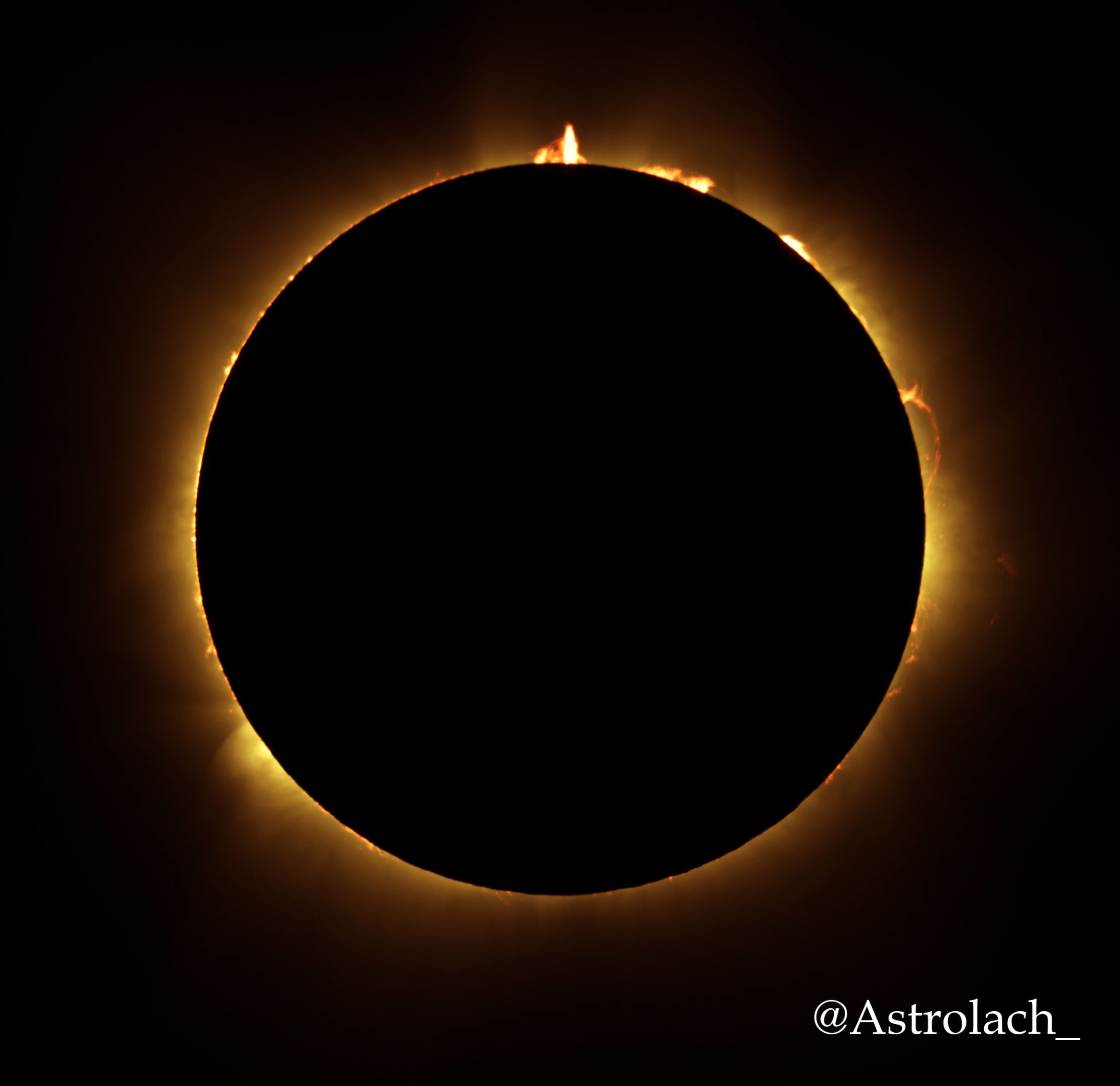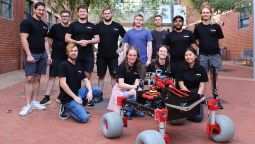Sun, Moon and Earth aligned: what it was like to witness the 2023 total eclipse at sea

Co-Director of Swinburne’s Space Technology and Industry Institute, Dr Rebecca Allen, travelled on board P&O Cruises’ specialist ‘Ningaloo King of Eclipses’ cruise to witness the 2023 total eclipse off the coast of Western Australia.
In summary
- Co-Director of Swinburne’s Space Technology and Industry Institute, Dr Rebecca Allen, travelled from Fremantle to the northwest cape of Exmouth to witness the 2023 total eclipse. She writes about her experience.
As the Co-Director of Swinburne’s Space Technology and Industry Institute, I am able to apply my background in astrophysics to help translate Swinburne’s cutting-edge research into ways to help grow Australia’s space industry, including finding amazing opportunities for our students. However, I will always have a passion for communicating the wonders of our Universe and getting to witness them firsthand.
So when I was invited to be the Astronomical Society of Australia’s ambassador for P&O’s Ningaloo Eclipse Cruise, giving me the chance to see my first total solar eclipse and help produce a professional astronomy outreach program, I said yes immediately.
I teamed up with Jackie Bondell, Education and Public Outreach Coordinator for the ARC Centre of Excellence for Gravitational Wave Discovery (OzGrav) and chair of the ASA’s Education and Public Outreach Committee. We worked to create a portfolio of diverse researchers and presenters and were honoured when Krystal DeNapoli agreed to join us to talk about Indigenous Astronomy.
I don’t think the cruise line had ever had a 12 inch Dobsonian Telescope brought on board or considered how hard it would be to photograph an eclipse on a moving ship. Our cruise departed Monday 17 April, but the eclipse was not going to happen until around midday on 20 April so there was plenty of time for us to fill.
Krystal and I were scheduled to speak the first day, so we didn’t have much time to get our sea legs before jumping on stage. Krystal’s talk was incredibly well received with copies of her book, Sky Country, selling out in minutes. I talked about the James Webb Space Telescope and the amazing science that our researchers, including Professor Karl Glazebrook, Dr Themiya Nanayakkara and Associate Professor Ivo Labbe, are undertaking. I also spoke about how Australians are using similar technology and techniques to study Earth and rapidly detect dangerous events such as bushfires.
Total solar eclipses are special for a few reasons. Our Moon is just the right size and distance that it occasionally eclipses the Sun during a new Moon (the phase of the Moon where the Moon appears completely in shadow because the Sun is behind it from Earth’s point of view).
But we don’t get a total eclipse every new Moon because the Earth-Moon distance changes, and the Moon isn’t always in the correct plane of its orbit to totally block the Sun’s light. When this alignment comes together we get an eclipse… but they only last seconds to minutes. As Earth is mostly water, the path of totality rarely crosses a highly populated location. It can be decades to centuries before crossing the same place again.
Observing an eclipse by ship is advantageous because you can move to the best location to capture the longest period of totality (when the Sun is completely covered by the Moon and is safe to look at). If you look at the map below you can guess where we tried to be. To have stability for photographers we opted for a location a bit closer to land, but within the 60 second zone.

The days flew by, with our talks and presentations receiving fantastic feedback. On Thursday morning the ship was bustling early on with guests staking out ideal places to view and capture the eclipse.
Matt Dodds, an educator, outreach program coordinator, and astrophotographer (@stargazingadventures) and his mentee, Lachlan Wilson (@astrolach), a seventeen-year-old award winning astrophotographer, were positioned in the middle of the deck between the swimming pools where they could capture the entire event.
We headed to the back of the ship to a special area, where we made pin hole cameras with Jatz crackers (I had to keep my 18-month-old from eating them) and waited patiently as the sky slowly darkened. Over the course of about 90 minutes, we checked the eclipse’s progress with special viewers and even adapted a few to take pictures with our smartphones. At 11:20 we were informed over the PA system that the main event was almost here. The ship got dramatically quiet as the final minutes ticked by and we tried to be still so as not to disturb the photographers.

Image credit: Lachlan Wilson @astrolach
And then it happened, the Moon slipped in front of the Sun and for almost 60 seconds we sat in eery darkness as the Sun’s corona was on full display. And then it was over.
I instantly understood the addiction of eclipse chasers seeking to experience this unique cosmic event. We watched as the Moon continued to make her way and reveal the Sun’s disk again. It was a perfect eclipse with not a cloud in the sky and we knew we had seen something special.

Image credit: Matt Dodds, @stargazingadventures and Lachlan Wilson @astrolach
I can’t wait until 2028 when the next solar eclipse will cross Australia from the tip of WA to Sydney with almost five minutes of totality.
Dr Allen was a paid speaker on board P&O Cruises’ specialist ‘Ningaloo King of Eclipses’ cruise to witness the 2023 total eclipse.
-
Media Enquiries
Related articles
-

- Astronomy
High school students work with Swinburne astronomers on the future of space
Swinburne’s Youth Space Innovation Challenge has inspired over 330 Australian teenagers to pursue a career in STEM.
Friday 26 July 2024 -

- Astronomy
- Science
Swinburne appoints new Director of Innovative Planet Research Institute
Leading geodesy expert, Professor Allison Kealy, has been appointed as the inaugural Director of Swinburne University's Innovative Planet Research Institute.
Monday 22 April 2024 -

- Astronomy
- University
OzGrav 2.0: A ‘new era of astrophysics’ launched at Swinburne
The next phase in the world-leading ARC Centre of Excellence for Gravitational Wave Discovery, dubbed 'OzGrav 2.0', launched this week at Swinburne University of Technology.
Wednesday 17 April 2024 -

- Design
- Astronomy
- Technology
- University
Swinburne ‘Rock Muncher’ takes part in Australian Rover Challenge
A multidisciplinary student team from Swinburne University of Technology competed in the 2024 Australian Rover Challenge held in Adelaide, South Australia.
Thursday 11 April 2024 -
.jpeg/_jcr_content/renditions/cq5dam.web.256.144.jpeg)
- Astronomy
New JWST observations reveal black holes rapidly shut off star formation in massive galaxies
New research showcases new observations from the James Webb Space Telescope that suggest black holes rapidly shut off star-formation in massive galaxies by explosively removing large amounts of gas...
Tuesday 23 April 2024

